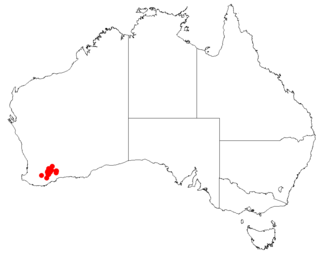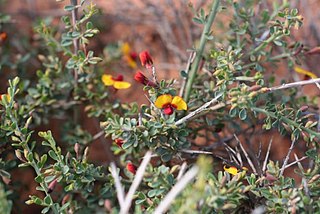
Bossiaea spinosa is a species of flowering plant in the family Fabaceae and is endemic to the south-west of Western Australia. It is a low, dense prostrate or rounded, twiggy shrub with egg-shaped to elliptic leaves and deep yellow to orange and pinkish-red, pea-like flowers.

Bossiaea halophila is a species of flowering plant in the family Fabaceae and is endemic to Western Australia. It is a dense, erect, many-branched shrub with narrow-winged cladodes, leaves reduced to small scales, and yellow-orange and deep red flowers.
Bossiaea arcuata is a species of flowering plant in the family Fabaceae and is endemic to a small area in Western Australia. It is an erect, openly-branched, more or less leafless shrub with often arched cladodes, and yellow and red pea-like flowers.
Bossiaea barbarae is a species of flowering plant in the family Fabaceae and is endemic to Western Australia. It is an erect, compact, spiny shrub with egg-shaped to elliptic or oblong leaves, and deep yellow and bright red flowers.
Bossiaea barrettiorum is a species of flowering plant in the family Fabaceae and is endemic to a restricted area in the Northern Kimberley region of Western Australia. It is low, spreading or prostrate shrub with winged stems, winged cladodes, leaves reduced to small scales, and deep yellow and red flowers.

Bossiaea calcicola is a species of flowering plant in the family Fabaceae and is endemic to the far west of Western Australia. It is compact, glaucous, spiny shrub with oblong, wedge-shaped or round leaves and bright yellow, reddish and greenish-yellow flowers.
Bossiaea celata is a species of flowering plant in the family Fabaceae and is endemic to Western Australia. It is a compact, many-branched shrub with flattened cladodes, leaves reduced to scales, and yellow to pinkish-red pea-like flowers.
Bossiaea cucullata is a species of flowering plant in the family Fabaceae and is endemic to Western Australia. It is a dense, many-branched shrub with narrow-winged cladodes, leaves reduced to dark brown scales, and yellow and deep red or pale greenish-yellow flowers.
Bossiaea eremaea is a species of flowering plant in the family Fabaceae and is endemic to Western Australia. It is an openly-branched, spreading, more or less leafless shrub with deep yellow and purplish flowers.
Bossiaea flexuosa is a species of flowering plant in the family Fabaceae and is endemic to Western Australia. It is a compact shrub with slightly flattened, zigzag branches, notched, more or less leafless cladodes, and golden yellow and red or pinkish flowers.
Bossiaea inundata is a species of flowering plant in the family Fabaceae and is endemic to the Murchison River Gorge in Western Australia. It is a spreading, openly-branched shrub with oblong, elliptic or egg-shaped leaves with the narrower end towards the base, and deep yellow and red flowers.

Bossiaea ornata, commonly known as broad leaved brown pea, is a species of flowering plant in the family Fabaceae and is endemic to the south-west of Western Australia. It is a shrub with variably-shaped leaves, typically egg-shaped or oblong, and yellow or orange-yellow and reddish-brown flowers.
Bossiaea peduncularis is a species of flowering plant in the family Fabaceae and is endemic to Western Australia. It is an erect, more or less leafless shrub with arching branches, cladodes ending with a point and deep yellow, red and greenish-yellow flowers.
Bossiaea peninsularis is a species of flowering plant in the family Fabaceae and is endemic to the Eyre Peninsula in South Australia. It is an erect rhizome-forming, more or less leafless shrub with leaves reduced to small scales, and yellow, red and purplish flowers.
Bossiaea praetermissa is a species of flowering plant in the family Fabaceae and is endemic to near-coastal areas in the far south-west of Western Australia. It is a shrub with many flattened, winged cladodes and deep yellow and reddish or maroon flowers.
Bossiaea preissii is a species of flowering plant in the family Fabaceae and is endemic to the south of Western Australia. It is a compact, glabrous shrub with egg-shaped leaves with the narrower end towards the base, and yellow, red, orange or apricot-coloured flowers.

Bossiaea rufa is a species of flowering plant in the family Fabaceae and is endemic to the south-west of Western Australia. It is a loose, many-branched shrub with elliptic to egg-shaped leaves with the narrower end towards the base, and deep yellow and red flowers.
Bossiaea saxosa is a species of flowering plant in the family Fabaceae and is endemic to a restricted area near Norseman, Western Australia. It is an erect, intricately branched shrub with many slightly flattened, sharply-pointed cladodes and deep yellow, red and lemon-yellow, pea-like flowers.
Bossiaea smithiorum is a species of flowering plant in the family Fabaceae and is endemic to the south-west of Western Australia. It is a slender shrub with oblong to cylindrical leaves and orange-yellow and red or purple, pea-like flowers.
Bossiaea spinescens is a species of flowering plant in the family Fabaceae and is endemic to the south-west of Western Australia. It is a slender, spreading or compact, spiny shrub with oblong to oval leaves and yellow and reddish-brown, pea-like flowers.





